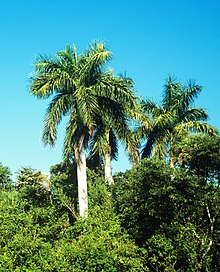Roystonea
|
Roystonea Temporal range: Miocene–Recent |
|
|---|---|
 |
|
| Roystonea regia | |
| Scientific classification | |
| Kingdom: | Plantae |
| (unranked): | Angiosperms |
| (unranked): | Monocots |
| (unranked): | Commelinids |
| Order: | Arecales |
| Family: | Arecaceae |
| Subfamily: | Arecoideae |
| Tribe: |
Roystoneae J.Dransf., N.W.Uhl, Asmussen, W.J.Baker, M.M.Harley & C.Lewis |
| Genus: |
Roystonea O.F.Cook |
| Type species | |
|
Roystonea regia (Kunth) O.F.Cook |
|
| Synonyms | |
|
Gorgasia O.F.Cook |
|
Gorgasia O.F.Cook
Roystonea is a genus of eleven species of monoecious palms, native to the Caribbean Islands, and the adjacent coasts of Florida and Central and northern South America. Commonly known as the royal palms, the genus was named for Roy Stone, a U.S. Army engineer. It contains some of the most recognizable and commonly cultivated palms in tropical and subtropical regions.
Roystonea is a genus of large, unarmed, single-stemmed palms with pinnate leaves. The large stature and striking appearance of a Roystonea palm makes it a notable aspect of the landscape. The stems, which were compared to stone columns by Louis and Elizabeth Agassiz in 1868, are smooth and columnar, although the trunks of R. altissima and R. maisiana are more slender than those of typical royal palms. Stems often are swollen and bulging along portions of their length, which may reflect years where growing conditions were better or worse than average. Leaf scars are often prominent along the stem, especially in young, rapidly growing individuals. Stem color ranges from gray-white to gray-brown except in R. violacea, which have violet-brown or mauve stems. The largest royal palm, R. oleracea, reaches heights of 40 metres (130 ft), but most species are in the 15 to 20 m (49 to 66 ft) range.
Roystonea leaves consist of a sheathing leaf base, a petiole, and a rachis. The leaf base forms a distinctive green sheath around the uppermost portion of the trunk. Known as the crownshaft, this sheath extends 1.4–2 metres (4 ft 7 in–6 ft 7 in) down the trunk. The petiole connects the lead base with the rachis. Zona only reported petiole lengths for three of the 10 species, ranging from 20 to 100 centimetres (8 to 39 in). The rachis is pinnately divided and ranges from 3.2 to 5.8 m (10 to 19 ft) long. The leaf segments themselves range in length from 60 to 79 cm (24 to 31 in) in R. altissima up to as much as 132 cm (52 in) in R. lenis. They are arranged in two or three planes along the rachis. Many authors have reported that the leaves R. oleracea are arranged in a single plane, but American botanist Scott Zona reported that this is not the case.
...
Wikipedia
